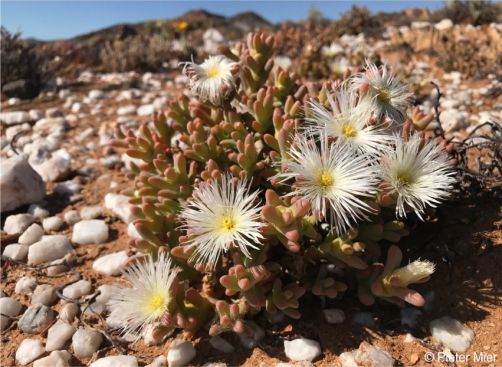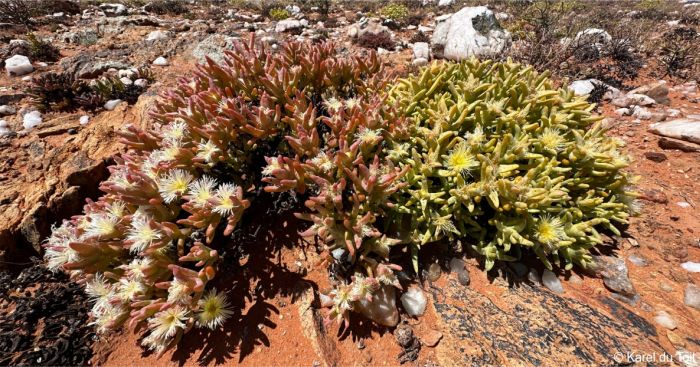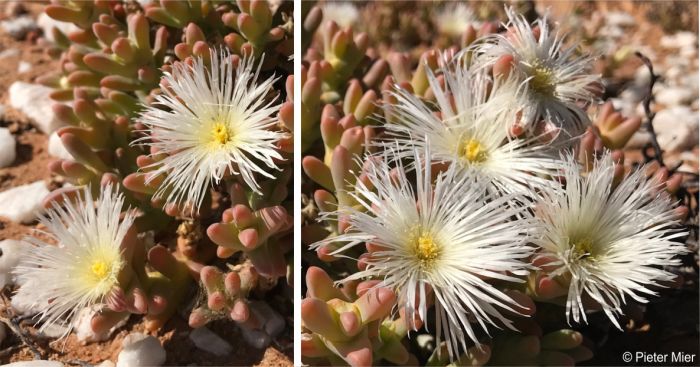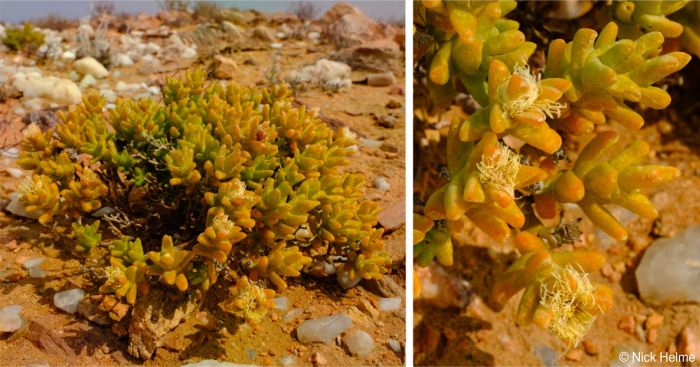Mesembryanthemum amplectens
Mesembryanthemum amplectens L.Bolus
Family: Aizoaceae
Common names: clasping ice plant (Eng.); klouvygie (Afr.)
Introduction
A distinctive low-growing succulent dominating the flat lands of the Richtersveld, forming a beautiful floral mat on open spaces with its eye-catching white flowers and fleshy stems and leaves.

Description
Description
Mesembryanthemum amplectens is a cushion-forming, succulent shrublet that often grows in a dome shape, with an average height of 200 mm and can spread horizontally up to 1 m wide. The plant is multi-stemmed, with many small branches that are clustered close to the ground. The stems are almost fleshy when young and harden as the plant grows older. The bark of the plant is brown and coarse in texture. Branches are covered with thick, smooth leaves that are covered in bladder cells. The leaves are arranged oppositely and ranked in fours, and are about 25 mm long on average. The leaves are angled vertically, and are close to each other in such a way that there is no space in-between the nodes. The colour of the leaves is green, but when a plant is more exposed to the sun, leaves tend to change colour, becoming yellowish or reddish, leaving the plant looking green with shades of yellow and red. This species flowers in late spring to summer (November to January), displaying bright white or pale yellow mesemb flowers with a yellow centre. The period of flowering also depends on the environmental conditions, whether they are favourable at that time. These flowers are on average 45 mm in diameter, and are solitary, on single flower stalk at the tip of a branch. The fruit is a capsule that is usually covered by leaf-like material, which feels fleshy, although the slightly hard capsule can be felt inside the covering. These capsules contain many tiny, brown to black seeds, that can be collected in late summer to autumn.

Conservation Status
Status
The conservation status of Mesembryanthemum amplectens is Least Concern (LC) according to the SANBI Red List of South African Plants, which simply indicates that there are no threats upon this species.
Distribution and habitat
Distribution description
Mesembryanthemum amplectens is native and endemic to South Africa and is only found in the Northern Cape. This ice plant is widely distributed in the Richtersveld Bioregion, in the Port Nolloth surroundings towards the north of the Northern Cape and in Namaqualand, where it dominates in the sandveld. Plants are found growing predominantly on the sandy to sandy-rocky flats and quartzite hills of the Succulent Karoo Biome. Their preferred habitat usually has sandy soil and is mostly in rocky areas and mountains, which receive precipitation in winter, and experience a dry summer. The mean annual rainfall of their habitat varies between 50–120 mm. This region is also well known for experiencing extreme temperatures, ranging from above 40°C in summer to below 10°C in winter.

Derivation of name and historical aspects
History
The name Mesembryanthemum is derived from the Greek language, with mesembria meaning ‘noon’ and anthemon meaning ‘flowering’. The original name was spelled Mesembrianthemum, and was given by Breyne, in 1684, to describe the opening of flowers at noon. Eventually as new species were discovered, night-flowering species were also discovered and the name seemed inappropriate; it was then changed so that it could indicate a flower with its fruit in the middle i.e. mesos, meaning ‘middle’, embryon, meaning ‘embryo’ or ‘fruit’, and anthemom, meaning ‘flower’, thus ‘flower with its fruit in the centre’. The spelling was thus changed to Mesembryanthemum.
The specific epithet amplectens means ‘entangled’ or ‘clasping’, ‘embracing at the base’ which simply describes how the base of the leaves clasp the stem. The species M. amplectens was first published in 1913 by Louisa Bolus (1877–1970), she was a South African botanist and taxonomist who was based in Cape Town, South Africa. Mesembryanthemum amplectens was moved into the genus Aspazoma by N.E. Brown in 1926, but moved back to Mesembryanthemum in 2007 by Klak, Bruyns and Hedderson.
The genus Mesembryanthemum falls under the sub-family Mesembryanthemoideae, which is one of the five subfamilies found in the Aizoaceae. The other four subfamilies are Tetragonioideae, Sesuvioideae, Aizooideae and Ruschioideae. The family Aizoaceae contains 135 genera and about 1 800 species. This family is commonly known as the vygies in southern Africa. Most species in this family are endemic to arid and semi-arid regions of southern Africa, in the Succulent Karoo Biome. Many of the species in the diverse Aizoaceae are found in the Greater Cape Floristic Region, which is one of the world’s biodiversity hotspots.
Ecology
Ecology
The pollinating agents for Mesembryanthemum amplectens include many insects, such as bees, flies and moths, although, bees are considered the primary pollinators of this species. Similar to other mesembs, seed dispersal is effected by capsules opening up when wet and releasing seeds. In the wild, this happens on rainy days and when seeds are ready for dispersal and seeds are thus dispersed when mature and when conditions are favourable for germination. Seeds can be dispersed a short distance away from the mother plant or may flow a further distance through water run-off. On the dry days, the capsules close again as they dry out, to protect the remaining seeds inside. Most mesembs have the ability to store water in their fleshy stems and leaves, which gives them an advantage to survive drought and arid conditions.

Uses
Use
Mesembryanthemum amplectens can be edible to animals, mainly during drought conditions when alternative plants for grazing are not available. In landscaping and horticulture, M. amplectens can be mass planted to improve soil stability and avoid soil erosion. It can also serve as a ground cover, providing beauty in the garden – especially on sunny days, when its big and bright flowers are open. The plant gives a great display in the garden, particularly when located near the front screenless fence towards the entrance. Ice plants, including M. amplectens, can serve as the habitat for and will attract insects, such as ants, and pollinators such as bees. Also, this species would do well as a display plant in a sunny rockery bringing colour and texture to arid or water-wise gardens, in winter-rainfall regions.
Growing Mesembryanthemum amplectens
Grow
Mesembryanthemum amplectens is easy to propagate by seeds sown in autumn, between March and May. With this species reproducing easily and effectively in the wild, seeds can be sown directly in the field, given that the soil conditions and environmental conditions of the garden are optimal. M. amplectens prefers to be grown in a position in full sun, with dry or limited-moisture soils. For nursery propagation, the growth medium for propagating this plant should contain a mixture of 60% coarse river sand and 40% sifted compost, but is not limited to the recommended growth medium, other germination mixes suitable for succulents may be used. The germination mix must be uniform and sifted to get rid of coarse particles and other objects that might limit the germination success. Use germination trays that are shallow, to allow satisfactory drainage and air circulation. Sow the seeds gently and evenly on top of the soil inside the trays and lightly cover them with the soil. Provide them with water using a fine sprayer so that the seeds will not be washed out of position, and keep the soil damp but not wet. Similar to its relatives, this species would probably take 2–3 weeks to germinate. Place seed trays and germinated seedlings under a roof that allows in some light but not direct sunlight, as that might be harsh for seedlings grown under proper care.
This ice plant has not been propagated by cuttings in the Karoo Desert National Botanical Garden. For some Mesembryanthemum species, other methods of propagation are recommended, depending on the plant, if there are any difficulties with seed germination or root development. The related species M. varians has previously been reproduced by cuttings at Karoo Desert National Botanical Garden. Riddles recommends that tip cuttings about 5 cm long are collected from a healthy mother plant in spring and planted in washed coarse river sand. Softwood rooting hormone can be used to promote rooting. Place the cuttings trays in a warm production house with light shade and water them with mist sprayer. Rooted cuttings should be transplanted into well-drained soil containing organic content of at least 30%.
Transplanting must be done when the seedlings have grown large enough to be handled or when cuttings have rooted, ideally and on average this is two months after germinating or immediately after rooting. Ttransplanted seedlings must be moved to the hardening-off section, so that the plants get to adapt to brighter light and the external environment. The young plants will take quite some time to adapt when it has been moved from the nursery to an exposed area because it must adapt to new environmental conditions before growing. During this period, the plants must be very closely monitored.
In the garden, grow the plant in sunny areas where the soil is sandy and well-drained, and where it will not be watered too much. It is suitable to be planted as a ground cover and for seasonal colour in the garden. The species M. varians is one of the species that requires almost the same treatment as M. amplectens. The plants can be affected by fungal diseases when it is not well maintained in the garden; such as receiving too much water, or being situated in soil that holds too much moisture, or where there is not enough circulation of air, and exposure to pests. When the plant is experiencing such difficulties, the grower should make sure that the cultural and mechanical methods of maintenance (primary control methods) are in place before opting to use fungicides. These control measures can include removing severely affected plants, spacing plants more widely by opening spaces in between the plants, removing weeds in the garden beds (weeds can act as pest and disease hosts) and making sure that the watering regime is suitable for their water requirements.
References
- Chesselet, P. 2004. Mesembryanthemaceae (Aizoaceae) Class: Dicotyledonae (Angiosperms) Order: Caryophyllales. PlantZAfrica. Online. https://pza.sanbi.org/mesembryanthemaceae.
- Du Toit, K. 2023-Oct. Observation of Mesembryanthemum amplectens, Namaqualand, Northern Cape. iNaturalist. Online. https://www.inaturalist.org/observations/188929280.
- GBIF. Mesembryanthemum amplectens L.Bolus: https://www.gbif.org/species/3708195. Accessed on 2024-07-12.
- Helme, N. 2022-Aug. Observation of Mesembryanthemum amplectens, Namaqualand, Northern Cape. iNaturalist. Online. https://www.inaturalist.org/observations/134725319.
- Klak, C. & Bruyns, P.V. 2013. A new infrageneric classification for Mesembryanthemum (Aizoaceae: Mesembryanthemoideae). Bothalia 43(2):197–206.
- Klak, C., Bruyns, P.V. & Hedderson, T.A.J. 2007. A phylogeny and new classification for Mesembryanthemoideae (Aizoaceae). Taxon 56: 737-756.
- Klak, C., Hanáček, P. & Bruyns, P. V. 2014. Phylogeny and taxonomy for Mesembryanthemum subg. Volkeranthus (Aizoaceae-Mesembryanthemoideae). South African Journal of Botany 95:112–122.
- Mier, P. 2021-Sep. Observation of Mesembryanthemum amplectens, Namaqualand, Northern Cape. iNaturalist. Online. https://www.inaturalist.org/observations/98527185.
- Mucina, L. & Rutherford, M.C. (eds) 2006. The vegetation of South Africa, Lesotho and Swaziland. Strelitzia 19. South African National Biodiversity Institute, Pretoria.
- Ncaphayi, S. 2019. Mesembryanthemum crystallinum L. (Aizoaceae). PlantZAfrica. Online. https://pza.sanbi.org/mesembryanthemum-crystallinum.
- Raimondo, D., Von Staden, L., Foden, W., Victor, J.E., Helme, N.A., Turner, R.C., Kamundi, D.A. & Manyama, P.A. (eds) 2009. Red list of South African plants. Strelitzia 25. South African National Biodiversity Institute, Pretoria.
- Riddles, R. 2014. Mesembryanthemum varians Haw. (Aizoaceae). PlantZAfrica. Online. https://pza.sanbi.org/mesembryanthemum-varians
- The Plant List. Mesembryanthemum amplectens L. Bolus. http://theplantlist.org/tpl/record/tro-100362162. Accessed on 12/07/2024.
- Van Jaarsveld, E.J. & Pienaar, U. de V. 2000. Vygies, gems of the veld. Cactus & Co. Libri, Venegono, Italy.
- WFO The World Flora Online. Mesembryanthemum amplectens L.Bolus. http://www.worldfloraonline.org/taxon/wfo-0000371402. Accessed on 11 Jul 2024.
Credits
Thabang Makola & Nonjabulo Nzama
Karoo Desert National Botanical Garden
October 2024
Acknowledgements: images by Karel du Toit, Nick Helme and Pieter Mier.
Plant Attributes:
Plant Type: Shrub, Succulent
SA Distribution: Northern Cape
Soil type: Sandy
Flowering season: Spring, Early Summer
PH: Acid
Flower colour: White, Cream
Aspect: Full Sun
Gardening skill: Average
Special Features:
Horticultural zones







Rate this article
Article well written and informative
Rate this plant
Is this an interesting plant?
Login to add your Comment
Back to topNot registered yet? Click here to register.